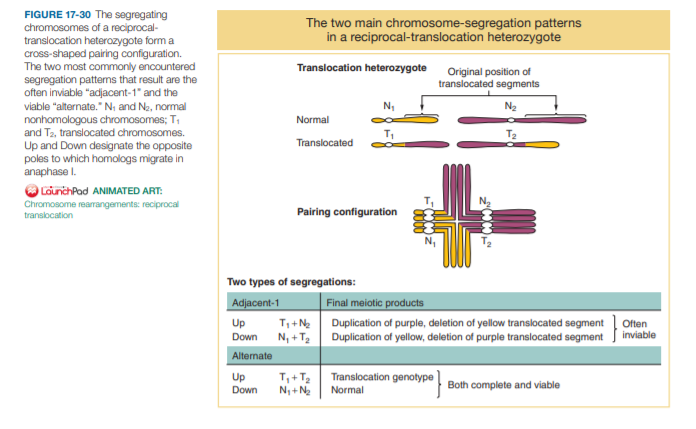FIGURE 17-30 The segregating chromosomes of a reciprocal- translocation heterozygote form a cross-shaped pairing configuration. The two most commonly encountered segregation pattems that result are the often inviable "adjacent-1" and the viable "alternate." N, and N2, normal The two main chromosome-segregation patterns in a reciprocal-translocation heterozygote Translocation heterozygote Original position of translocated segments nonhomologous chromosomes; T, and T2, translocated chromosomes. Normal Translocated Up and Down designate the opposite poles to which homologs migrate in anaphase I. O LounchPad ANIMATED ART: Chromosome rearangements: reciprocal transocation Pairing configuration N, Two types of segregations: Adjacent-1 Final meiotic products Often inviable Up T, +N2 Duplication of purple, deletion of yellow translocated segment Duplication of yellow, deletion of purple translocated segment Down N, + T2 Alternate Up Translocation genotype Down N+N Normal Both complete and viable
FIGURE 17-30 The segregating chromosomes of a reciprocal- translocation heterozygote form a cross-shaped pairing configuration. The two most commonly encountered segregation pattems that result are the often inviable "adjacent-1" and the viable "alternate." N, and N2, normal The two main chromosome-segregation patterns in a reciprocal-translocation heterozygote Translocation heterozygote Original position of translocated segments nonhomologous chromosomes; T, and T2, translocated chromosomes. Normal Translocated Up and Down designate the opposite poles to which homologs migrate in anaphase I. O LounchPad ANIMATED ART: Chromosome rearangements: reciprocal transocation Pairing configuration N, Two types of segregations: Adjacent-1 Final meiotic products Often inviable Up T, +N2 Duplication of purple, deletion of yellow translocated segment Duplication of yellow, deletion of purple translocated segment Down N, + T2 Alternate Up Translocation genotype Down N+N Normal Both complete and viable
Human Heredity: Principles and Issues (MindTap Course List)
11th Edition
ISBN:9781305251052
Author:Michael Cummings
Publisher:Michael Cummings
Chapter6: Cytogenetics: Karyotypes And Chromosome Aberrations
Section: Chapter Questions
Problem 1QP: Analyzing Karyotypes 1. Originally, karyotypic analysis relied only on size and centromere placement...
Related questions
Question
Based on Figure 17-30, are normal genomes ever formed
from the two types of segregation? Are normal genomes
ever formed from an adjacent-1 segregation?

Transcribed Image Text:FIGURE 17-30 The segregating
chromosomes of a reciprocal-
translocation heterozygote form a
cross-shaped pairing configuration.
The two most commonly encountered
segregation pattems that result are the
often inviable "adjacent-1" and the
viable "alternate." N, and N2, normal
The two main chromosome-segregation patterns
in a reciprocal-translocation heterozygote
Translocation heterozygote
Original position of
translocated segments
nonhomologous chromosomes; T,
and T2, translocated chromosomes.
Normal
Translocated
Up and Down designate the opposite
poles to which homologs migrate in
anaphase I.
O LounchPad ANIMATED ART:
Chromosome rearangements: reciprocal
transocation
Pairing configuration
N,
Two types of segregations:
Adjacent-1
Final meiotic products
Often
inviable
Up
T, +N2 Duplication of purple, deletion of yellow translocated segment
Duplication of yellow, deletion of purple translocated segment
Down N, + T2
Alternate
Up
Translocation genotype
Down
N+N
Normal
Both complete and viable
Expert Solution
This question has been solved!
Explore an expertly crafted, step-by-step solution for a thorough understanding of key concepts.
This is a popular solution!
Trending now
This is a popular solution!
Step by step
Solved in 2 steps

Knowledge Booster
Learn more about
Need a deep-dive on the concept behind this application? Look no further. Learn more about this topic, biology and related others by exploring similar questions and additional content below.Recommended textbooks for you

Human Heredity: Principles and Issues (MindTap Co…
Biology
ISBN:
9781305251052
Author:
Michael Cummings
Publisher:
Cengage Learning

Human Heredity: Principles and Issues (MindTap Co…
Biology
ISBN:
9781305251052
Author:
Michael Cummings
Publisher:
Cengage Learning